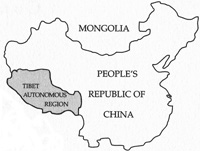
| Erica B. Svatek |
An Interdisciplinary Study of the Himalayan Region
| Home |
| Geography |
| Religion |
| Literature
& Art |
| Modern Conflicts |
| Connections |
| Resources |
| About the Author |
| Bibliography |

Tibet is located in the western part of China in the Himalayan Mountains. Tibet is the modern center for Buddhist practice. Religion, daily life, and politics are intertwined. Tibet's history is rich, complex, and covers an expanse of diverse geography that few other areas of the world can rival. Tibet is a religious and geopolitical hot spot.
A great deal of controversy exists as to whether or not Tibet was ever really part of China. Its linguistic, economic, political, and cultural history differ from that of China. However, during Mao Zedong's Cultural Revolution, new emphasis was placed on fully incorporating Tibet into China. This takeover was brutal, violent, and destroyed a great deal of Tibetan and Buddhist literature, artwork, and culture. The Dali Lama had to flee Tibet and currently holds a government in exile in India.
Today the debate continues for Tibetan independence continues. This region of the world is a hot spot of political, economic, and cultural controversy. Is Tibet ready for independence, yes and no. Tibet has no education system, no way to care for its people, and no infrastructure for its government. The Tibetan people have little voice or say in the current Chinese run government. Nonetheless, Tibet has its own heritage, culture, and language to preserve. This is a debate all students should learn about, research, and engage in.